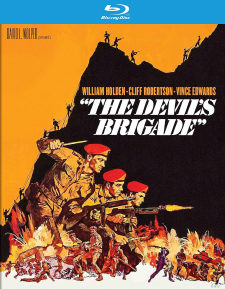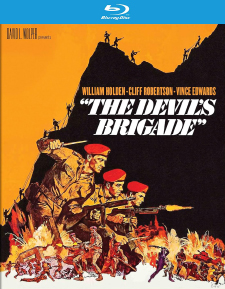Devil’s Brigade, The (Blu-ray Review)

Director
Andrew V. McLaglenRelease Date(s)
1968 (January 16, 2024)Studio(s)
Wolper Pictures/United Artists (Kino Lorber Studio Classics)- Film/Program Grade: C+
- Video Grade: C+
- Audio Grade: B-
- Extras Grade: B-
Review
The Devil’s Brigade (1968) is a competently made but instantly forgettable World War II film. How forgettable? I saw it on DVD 20 years ago yet, watching Kino’s new Blu-ray, I discovered there wasn’t a single moment in the picture I had remembered.
The film went into production just as Robert Aldrich’s game-changing The Dirty Dozen (1967) went into release. It was therefore a coincidence that so much of The Devil’s Brigade mirrored plot points with The Dirty Dozen, yet unfavorable comparisons were inevitable. Director Andrew V. McLaglen later stated his original cut of the film was quite good, generating much enthusiasm, but that the producers and studio executives kept tinkering with it, probably to play up similarities with The Dirty Dozen, thus severely damaging the released version of the film. Maybe that’s true to some extent, but I suspect even McLaglen’s original cut probably wasn’t all that great, either.
The film is based on the same-named novel written by historian Robert H. Adleman and Col. George Walton, a member of the brigade, considered a forerunner to the later Green Berets. The plot revolves around a joint American-Canadian commando unit, the American side drawn from misfits, criminals, and wash-outs the rest of the Armed Forces want no part of.
A weary-looking William Holden stars as Lt. Col. Robert T. Frederick, a staff officer flown to England to meet with Lord Mountbatten (Patric Knowles), he ordering Frederick to assemble an American-Canadian commando force for a suicide mission into German-occupied Norway.
At a dilapidated, abandoned military camp in Montana, Frederick receives the American troops. The Canadians, under the command of Maj. Alan Crown (Cliff Robertson), are far more disciplined. Naturally, the crack Canucks hate the slovenly, rebellious Americans and vice versa—until, that is, the two sides join forces in an epic barroom brawl against a gang of lumberjacks (!), a melee straight out of one of McLaglen’s John Wayne movies.
The brigade is threatened with disbandment when their original mission is canceled but instead blustery Gen. Matt Clark (Carroll O’Connor) begrudgingly allows the brigade to prove its mettle reconnoitering a Wehrmacht garrison in an Italian village. Disregarding orders, under Frederick’s command they manage to capture the entire town without a single man killed (not likely). Clark then orders Frederick’s brigade on its first “real” mission, to scale an Italian plateau and capture Monte la Difensa, a German stronghold.
Similarities to Dirty Dozen aside, The Devil’s Brigade is chock-full of overly familiar genre tropes done better in other films, populated by a good cast who’d played similar characters in those films. Holden, for instance, had played scads of world-weary military officers, never coming close to topping his role in David Lean’s The Bridge on the River Kwai (1957). O’Connor had played variations of the same character in both the serious In Harm’s Way (1964) and comedic What Did You Do in the War, Daddy? (1967). Richard Jaeckel, in both this and The Dirty Dozen, had been playing similar parts going all the way back to Guadalcanal Diary in 1943. Jaeckel, by this time, was 41 years old. Indeed, virtually no one in the cast is age-appropriate. Among those playing enlisted men and junior officers: 41-year-old Claude Akins, 52-year-old Jack Watson, 36-year-old Richard Dawson, 46-year-old Harry Carey, Jr. Where are all the 18-19-20 year-olds?
Son of actor Victor McLaglen, Andrew V. directed his first feature, Man in the Vault, in 1956, after learning the craft as an assistant, often on John Ford and/or John Wayne films. His early features didn’t amount to much, but then he turned to series television, particularly the best-written TV Westerns Have Gun – Will Travel and Gunsmoke. On the latter series especially McLaglen brought a movie-level sheen. The comic Western Mclintock! (1963) with John Wayne brought him back to feature films. Again, he frequently but hardly exclusively worked with Wayne, and proved as adept with contemporary action films like The Wild Geese (1978) and North Sea Hijack (aka ffolkes) (1979) as Westerns. With frequent cinematographer William H. Clothier, The Devil’s Brigade is a handsome production—it’s just not very good.
Though populated with dozens of characters, none of them, Holden’s included, rise above genre stereotypes, giving talented actors like Jeremy Slate and Andrew Prine little to work with. Although in its crude way it shows how the Americans and Canadians finally bond, little hint is provided as to how the American side could virtually overnight become so adept in the field, including scaling straight up a mountain and taking out a well-armed German garrison in just three hours. Even the team behind The Guns of Navarone couldn’t have managed that.
Kino’s Blu-ray also disappoints. It looks like a very old—possibly 20 years-old—video transfer. Process shots including dissolves are notably soft and grainy simultaneously. There’s a fair amount of speckling and occasional damage. Some German dialogue is translated with English subtitles, but rather than replace those aged, dupey opticals with video-supered subs that would allow better film elements, the theatrical release version of these subtitles have been left in, as-is. By early 2000s standards it looks okay for a high-def release, but it should look much better in 2024. The DTS-HD Master Audio (2.0 mono) is okay, and optional English subtitles throughout is offered. The disc is Region “A” encoded.
Extras include a trailer, one that amusingly cashes in on producer David L. Wolper’s association with documentaries; and a new audio commentary track by Steve Mitchell and Steven Jay Rubin, the latter the author of Combat Films: American Realism. It’s a better than average track.
The Devil’s Brigade is too well made to be terrible, but it has nothing new to offer and quickly forgotten, and the lackluster video transfer also disappoints, making this for war movie aficionados only.
- Stuart Galbraith IV

